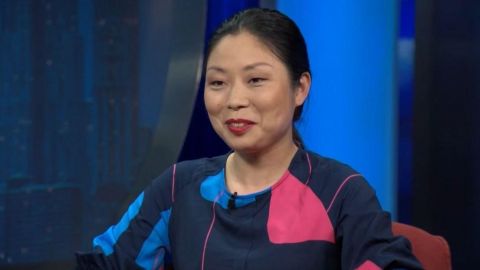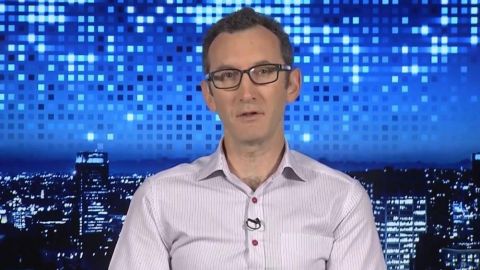Read Transcript EXPAND
CHRISTIANE AMANPOUR: Between politics and family with our next guest, the filmmaker Nanfu Wang. She’s using her lens to capture the devastating cost of China’s One-Child Policy for her new award-winning film, One Child Nation. Nanfu Wang sat down with our Hari Sreenivasan.
HARI SREENIVASAN, CONTRIBUTOR: So first, let’s just talk about the One- Child Policy for people who don’t know that. The Chinese government says that they prevented 380 million births. How does a state pull something like that off?
NANFU WANG, CO-DIRECTOR, PRODUCER, ONE CHILD NATION: Well, those 380 million is actually a number that was released years ago, like decades ago. So the number is much — the real number is much, much higher than that.
SREENIVASAN: OK.
WANG: And you know, it’s a country with a billion people and the policy was enforced throughout just the country. And almost every woman I know, my mom’s generation, even my grandma’s generation. My grandma was one of the first generations in the village who got the first sterilization. Every woman basically had gone through either force abortion or definitely forced sterilization.
SREENIVASAN: Because the policy ran for, what, 35 years?
WANG: Yes, over 35 years.
SREENIVASAN: So it affected multiple generations of childbearing women?
WANG: Absolutely.
SREENIVASAN: And if a woman did not want a forced sterilization or an abortion, what happened?
WANG: That’s what is a kind of forest. Every level of the government, there is village, town, city and the province, there are family planning officials. Their entire job responsibility is to find out whether a woman is pregnant with her second child or not and to who had just had a baby, and making sure that once a woman have had a child, then the next thing they would do is to sterilize that woman.
SREENIVASAN: All right. Let’s take a look at a clip from your trailer.
(BEGIN VIDEO CLIP)
WANG: None of my family questioned the policy or how it was implemented.
UNIDENTIFIED MALE: If I were born a girl, I would have been put unto a basket and sent away.
UNIDENTIFIED FEMALE: You still think the One-Child Policy is good, right?
UNIDENTIFIED FEMALE: Yes, people used to starve to death.
UNIDENTIFIED FEMALE: I was the one who killed. I was the executioner.
UNIDENTIFIED FEMALE: It was like fighting a war. Death is inevitable.
UNIDENTIFIED MALE: The Chinese government would come in and they’d bash down your house, take the child.
UNIDENTIFIED FEMALE: About eight or nine people came and took her away. This is where we hid.
UNIDENTIFIED FEMALE: My dad told me that I have an identical twin sister who lives in the U.S. now.
UNIDENTIFIED FEMALE: The fraud and corruption I discovered was nationwide. Were you and your family the biggest traffickers in the country?
UNIDENTIFIED FEMALE: Throughout my life, I was taught to believe the love of my country was equal to love the government and the party. I was so angry, even with my own family, that there wasn’t more to be said or done.
(END VIDEO CLIP)
SREENIVASAN: So the Chinese government, their rationale for this was what?
WANG: China has too many people and they are starving. There isn’t — there wasn’t enough food and resources for so many people so they had to control the population. And the way to do it is to have fewer people in each family. Thus when they came up with the idea of each family should just be allowed to have one child and they haven’t anticipated the consequences of implementing the policy in such a massive country.
SREENIVASAN: You interviewed the midwife who delivered you, right. And — but she’s also performed these sterilizations and she’s saying this out loud on camera and she’s even admitting to worse.
WANG: Yes. That was a long interview that really surprised me. I wanted to know from her. She’s 84-years-old and she delivered every baby in my village, including myself. So I went to see her and I asked her a very simple question, I was like how many babies do you think you delivered in your whole life? And she said, “Oh, I don’t remember that number. But I do remember I had done 50 to 60,000 abortions to the women, like throughout my career.” And that was complete shock in one — on the one hand of her openness. And on the second hand, it’s like, you know, how the number since she’s only a midwife in the village and there are midwives, you know, in the city, throughout the country, there are thousands of people like her. And that number a complete shock to me.
SREENIVASAN: And it’s sterilizations and abortions? And that’s over a period of 30 years?
WANG: Twenty-eight years, I believe.
SREENIVASAN: Twenty-eight years. And how — is it — do they keep all these records of all these?
WANG: She did the math for me. So the way that she would do it is because the midwife and the medical officials were in demand. So through January to June, like every day for six months, she would travel in a bus like among other midwives across the country, the region and like work seven days a week. They would take from town to town. And every day they would be at a place and officials would just bring women to that space and she would perform one sterilization. Each one takes 10 to 15 minutes. And then she would have — in June, she would have two weeks of a vacation. And then from after that to December, she would be on the road again and dothis, every day. And then she would have two weeks for the New Year and she did this for almost three decades. She described that they were like almost a tied like pigs to brought to her.
SREENIVASAN: I’m sorry. They were brought like what?
WANG: They were — the women were tied up like sometimes with ropes and almost like they’re tied pigs.
SREENIVASAN: Pigs?
WANG: Yes, when they brought to her to operate.
SREENIVASAN: Because these are women who did not consent?
WANG: Yes.
SREENIVASAN: And they had to be sterilized?
WANG: Yes.
SREENIVASAN: And she’s also describing really late-term abortions and she’s describing actually taking the life —
WANG: Yes.
SREENIVASAN: — of children after they are out?
WANG: Yes. One thing that she said to me and she was really painful when she said that was, you know when she performed all those abortions as a midwife, sometimes the babies were born — nine-month pregnancy, they were born a life. And because of the policy and her job, she had to kill them after they were born alive. And she is really traumatized by that. So today, she’s living with the guilt and trauma that she decided to only treat infertility disorders. She believed that if she can now help a couple to bring a baby to the world, she can kind of like —
SREENIVASAN: Atone?
WANG: Yes, atone her sins. In 2016, the One-Child Policy ended. So right now, it’s Two-Child Policy. And the government has realized over the past almost 40 years, the country now is facing the lack of workforce and a rapidly aging society. And there is a lack of, you know, young people to work and to care for the elderly. Ironically, the same kind of propaganda slogans are being used. And the same kind of tactics, fines, money, incentives are being used to encourage people to have more tuition. It’s almost like it’s opening a new chapter but with the same language and tactics of One-Child Policy.
SREENIVASAN: Let’s take a look at some of the tactics in another clip we have here.
(BEGIN VIDEO CLIP)
UNIDENTIFIED FEMALE: Men like Yosha Win worked all over China to promote the One-Child Policy. Since before I could even speak, I was surrounded by messages facing the policy. There was T.V., theatrical performances.
UNIDENTIFIED FEMALE: The One-Child Policy is truly great.
UNIDENTIFIED MALE: Fully implement our national policy.
UNIDENTIFIED FEMALE: And even children songs.
UNIDENTIFIED FEMALE: If you have a second child, you violate the law. Then you’ll be detained. If you try to escape, you will end up in jail. Think twice about it. Don’t say I didn’t warn you.
(END VIDEO CLIP)
SREENIVASAN: Your family, your mom, your aunts, relatives all still support the government’s position that this was necessary and frankly that it worked?
WANG: Yes. When I talked to my mom and my whole family, and they were like the policy was necessary. It contributed to the economic growth and that’s why our country and us survived. And I tried to argue with my mom but then I realized I couldn’t change her mind. And even after she has seen the film, she still believed it still. And it was so hard for me to understand. And I thought of it a lot. And eventually, I understood how effective the propaganda was. It was decades of message in education and every single message around them was saying how great the policy was and how necessary it was. And it was really hard to change the way that they think because they were not encouraged to ask questions and throughout their life, they were taught to not question.
SREENIVASAN: OK. Let’s take a look at a clip here as well.
(BEGIN VIDEO CLIP)
WANG: Becoming the mother felt like giving birth to my memories. The rash of images from my early life came back to me. I thought of my own parents and the name they give me. They chose the name Nanfu before I was born. Nan means man and Fu means pillar. They hoped for a boy who would grow up to be the pillar of the family. When I was born a girl, they named me Nanfu anyway. Hoping that I would grow up strong like a man.
(END VIDEO CLIP)
SREENIVASAN: You know it’s interesting that this brings into this intersection, this sort of deep-rooted cultural sexism, that it’s impossible to separate from the One-Child Policy. It added, as you point out, to the volume of abandoned babies that were literally being discarded. You share the story of your cousin and what happened to her. Something that your uncle had never really talked about and yet he did on camera about this. Tell us about that.
WANG: My uncle had a daughter and his mom wanted a grandson. So my grandma sort of like a threat on him is either me or your daughter. If you keep her, I’m going to commit suicide. And so my uncle was forced to give away the daughter. But at the time, no one wanted a daughter so he couldn’t give her away. And what he did was leaving the girl, the infant girl, I think she was only 20-days-old, and in the market where everybody was going to shop for grocery, the village market. And he was hoping that someone who goes to the market would see this girl and want it or like adopt her and take her home. And what happened was it was summer and he left her there overnight. No one showed up. No one wanted her. Another day, and the girl was bitten by mosquitoes all over her body and she died.
(BEGIN VIDEO CLIP)
WANG: My mom said that you cried for a long time.
UNIDENTIFIED MALE: Of course I did. Who wouldn’t? I cried non-stop when I gave her away.
WANG: After becoming a mom myself, I can’t even bear to listen to my child cry for more than three minutes. How did you deal with that?
UNIDENTIFIED MALE: My mom threatened to kill herself and said, ” If you keep this baby girl, I will either kill myself or I will strangle her to death first before killing myself.” I thought I could save her life by giving her away but she ended up dead.
(END VIDEO CLIP)
SREENIVASAN: You know, again and again throughout the film, you see people say they just had no choice. How did they — how did you get to that point where consistently all these people are able to sit by or they’re able to carry out policy? You spoke to a government worker that’s received lots of honors and so forth, and she was almost proud of it. You see the village elder who has his own reservations. There’s lots of different people even down to your family.
WANG: Yes.
SREENIVASAN: Had no choice.
WANG: When we started the film, I thought it was going to be a simple story. You know, there are perpetrators, there are victims. And then as soon as I met with the officials, the midwives, the people who carried out the policy, I soon realized that this were not bad people. They were not evil or they were not perpetrators. They were actually great people. They wanted to do a good job. They wanted to be contributing to the government. And I started thinking, like, what made these good people do evil things? And that was a narrative that I think throughout the world that we are familiar with that people say, “I follow the order, I don’t have a choice. The policy is the policy.” And especially in China, when people were educated to follow the order and especially to sacrifice their individuality and follow the collective belief, the collective, the greater good.
SREENIVASAN: You also examined another thread which is the trafficking of these babies. In 1992, China made it possible for foreigners to adopt children. And all of a sudden the world started to look at orphanages, “Wow, two Chinese baby girls, there’s so many of them. Can we adopt them?” You find a couple of different characters. One, a journalist in Hong Kong and a family in Utah who’ve been chronicling and cataloging the kind of unintended consequences of what happens when you basically create a market incentive.
WANG: What I learned was sometimes the government realized that they could actually make a profit out of the international adoption program. Each adoptive family go to China and they adopt the child and they would pay a fee. And all the orphanages were owned by the state. So they realized they could make money out of it. Then they would wait for a pregnant woman to carry the baby to full term, allow that to happen. And then once the baby was born, they would go then take the baby away, saying that they violated the One-Child Policy, and then put the baby in the orphanage for adoption.
SREENIVASAN: Is there any way the local governments did not know about this?
WANG: This was done by the local governments and it was not even one province or two. It happened in many different provinces across the country. And the journalists that we interviewed had done a lot of research. And he eventually was banned to live in China and then he had to move to Hong Kong.
SREENIVASAN: And the family that’s in Utah that’s trying to do DNA tests and trying to build a database. Basically, with limited success, they’ve been trying. But some of these are situations where twins have been separated at birth and they’re adopted and living in the United States without any knowledge that they have a sibling, a sister, more likely than not.
WANG: Yes. One of the examples was there were twin sisters and the government went and say they violated the One-Child Policy. So one twin was taken away and put in the orphanage and soon the twin was adopted by an American family. So they were separated like when they were infants.
SREENIVASAN: And the parents who adopted in the United States, it was also what tough for them to understand that what they thought was an orphanage and — but actually could have been a nefarious situation?
WANG: Absolutely. It was really hard for some families to accept the truth that their daughters, their children were not orphans. They have families. They have parents. And the government fabricated all the information.
SREENIVASAN: Ironically, China gets credited with pulling up out of abject poverty to 300 million people in a very short period of time, which is something no country has ever accomplished.
WANG: Yes, there is a lot of debate among economists, [13:55:00] sociologists, anthropologists whether and how much the One-Child Policy really had an effect on the country’s economy. And I think both sides of the debate, there’s no way to prove like this is the only factors that made it work or this does not have any contribution toward it. But I think one thing is clear is this policy had very severe human consequences.
SREENIVASAN: Nanfu Wang, thanks so much for joining us.
WANG: Thank you.
About This Episode EXPAND
Karen Bass and Christiane Amanpour discuss divisive rhetoric and racial tensions that persist in the United States. Jesse Moss and Jeff Sharlet join the program to speak about the new series, “The Family.” Nanfu Wang, co-director and producer of “One Child Nation,” sits down with Hari Sreenivasan to explain how the award-winning new film exposes the devastating cost of China’s one-child policy.
LEARN MORE


